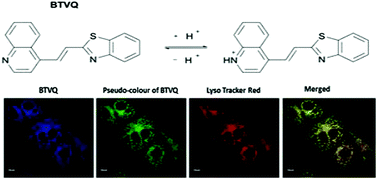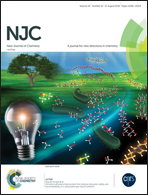Imaging of lysosomal pH changes with a novel quinoline/benzothiazole probe†
Abstract
A novel quinoline/benzothiazole pH probe (E)-2-(2-(quinolin-4-yl)vinyl)benzothiazole (BTVQ) was facilely synthesized. BTVQ exhibits remarkable emission response to pH and can image pH changes within the extreme acidity range of 3.0–3.8 with a pKa of 3.52. Moreover, BTVQ displays a notably large Stokes shift of 110 nm, which can reduce the excitation interference. BTVQ was successfully applied in HeLa cells and E. coli cells, suggesting that BTVQ can be employed as one of the few lysosome specific probes for imaging acidic intracellular pH changes, especially under extreme-acidity conditions in bacteria.



 Please wait while we load your content...
Please wait while we load your content...